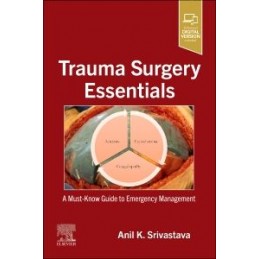- Obniżka


 Dostawa
Dostawa
Wybierz Paczkomat Inpost, Orlen Paczkę, DHL, DPD, Pocztę, email (dla ebooków). Kliknij po więcej
 Płatność
Płatność
Zapłać szybkim przelewem, kartą płatniczą lub za pobraniem. Kliknij po więcej szczegółów
 Zwroty
Zwroty
Jeżeli jesteś konsumentem możesz zwrócić towar w ciągu 14 dni*. Kliknij po więcej szczegółów
Opis
PART 1 Evaluation and Resuscitation of Trauma
SECTION I Initial Evaluation of Trauma Patients
1. Death in Trauma Patients
2. Process of Evaluation of Trauma Patients
SECTION I I Resuscitation of Trauma Patients
3. The Vicious Cycle of Trauma
4. Airway Assessment and Management
5. Management of Breathing and Ventilation
6. Assessment of Shock in Trauma Patients
7. Principles of Management of Hemorrhagic Shock
8. Viscoelastic Hemostatic Assay
9. Resuscitative Endovascular Balloon Occlusion of the Aorta
10. Monitoring of Resuscitation of Hemorrhagic Shock
PART 2 Emergency Management of Regional Trauma
SECTION III Head Trauma
11. Evaluation of Head Injury
12. Management of Severe Brain Injury
13. Scalp Laceration, Skull Fractures, and Facial Fractures
SECTION I V Spine Trauma
14. Cervical Spine Clearance
15. Evaluation and Management of Cervical Spine Injuries
16. Thoracic and Lumbar Spine Injuries
17. Evaluation and Management of Spinal Cord Injury
SECTION V Neck Trauma
18. Evaluation and Management of Blunt Neck Trauma
19. Evaluation and Management of Penetrating Neck Injuries
SECTION V I Chest Trauma
20. Emergency Thoracotomies
21. Evaluation and Management of Severe Thoracic Injuries
SECTION VII Abdominal Trauma
22. Evaluation and Management of Hemodynamically Unstable Abdominal Penetrating/Blunt Trauma
23. Evaluation and Management of Hemodynamically Stable Abdominal Penetrating/Blunt Trauma
24. Trauma Exploratory Laparotomy
25. Management of Liver Injuries
26. Evaluation and Management of Pancreatic Injuries
27. Evaluation and Management of Spleen Injuries
28. Evaluation and Management of Stomach and Duodenal Injuries
29. Management of Small Bowel, Colon, and Rectal Injuries
30. Evaluation and Management of Urological Injuries
SECTION VIII Vascular Trauma
31. Evaluation and Management of Retroperitoneal Vascular Injuries
32. Evaluation and Management of Vascular Injuries (Upper and Lower Extremities)
SECTION I X Musculoskeletal Trauma
33. Evaluation and Management of Pelvic Fracture Emergencies
34. Evaluation and Management of Extremity Fracture Emergencies
PART 3 Miscellaneous
SECTION X Pediatric Trauma, Trauma in Pregnancy, Scoring and Grading, Medications
35. Evaluation and Management of Pediatric Trauma
36. Evaluation and Management of Trauma in Pregnancy
37. Commonly Used Scoring and Grading Systems in Trauma
38. Medications in Emergency Trauma Management
